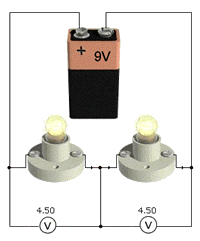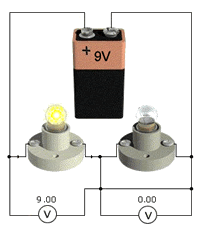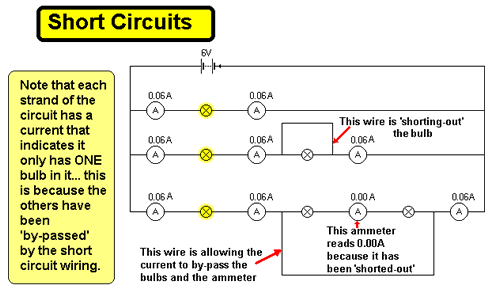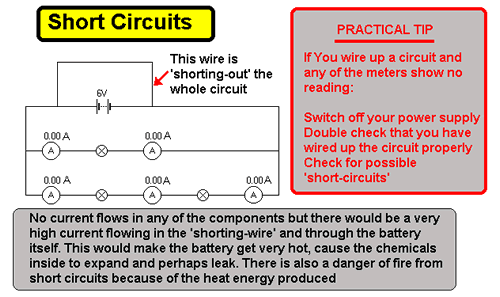|
Short
Circuits
 A short circuit is a low resistance path for the current to follow. It allows the majority of the current to flow through this easy route and very little then flows through the component it is 'shorting out'. You will observe shorted bulbs 'going out' or going very much dimmer, motors will stop turning and speakers stop producing sound.
Short circuits can cause very high currents to flow in power supplies or in wiring that it not designed for such a load. This can result in very hot wires and creation of a fire risk. Damage to components can occur. Circuits usually have a fuse included that will 'blow' if a 'short' causes too much current to flow. The high current causes the fuse wire to melt and that makes a gap in the circuit, breaking the connection and stopping the current flow before a fire occurs or an expensive component gets burned out. A fuse will therefore both protect the device and help prevent a fire risk.
Shorting out the cell or battery If you short out the cell or battery the whole circuit is shorted. A very high current flows though the shorting wire and virtually none goes through the components. All bulbs etc. would get hardly any current through them. The shorting wire and the battery would get very hot!
Try 'shorting out' components on Croc Clips...... Why do 'short circuits' occur? When components are in parallel the combination has a lower resistance than either of the lone components.
So, if a component is in parallel with a piece of conducting wire the shorted out component combination has less resistance than the component or piece of wire alone would have and therefore the shorted out component is part of a combination that has less resistance than a connecting wire!.It will therefore get a very little share of the voltage in the strand (unless it is on its own.... then it gets the lot anyway!). If a bulb in series with others is shorted out, it is as if it was not connected into the strand at all. It gets virtually no share of the potential drop from the battery and therefore very little current and it does not light up. The current in the strand will increase (as the resistance of the strand has decreased) and so the other bulbs will light up more brightly (as they would if it was not connected in at all). If a bulb on its own in a strand is shorted out, it still gets the full potential drop from the battery but in such a parallel arrangement the biggest share of the large current drawn from the battery flows through the strand of lowest resistance - the shorting wire. The wire gets the lion's share and the component gets virtually none and the energy from the battery is rapidly drained. Such a large current flows that the battery and wires get very hot. This can cause a fire! If you short out a single component when connected to a lab pack the safety switch will 'trip' stopping the dangerously high current from causing a problem. LOJ (reviewed May 2005) |
Follow me...
|










